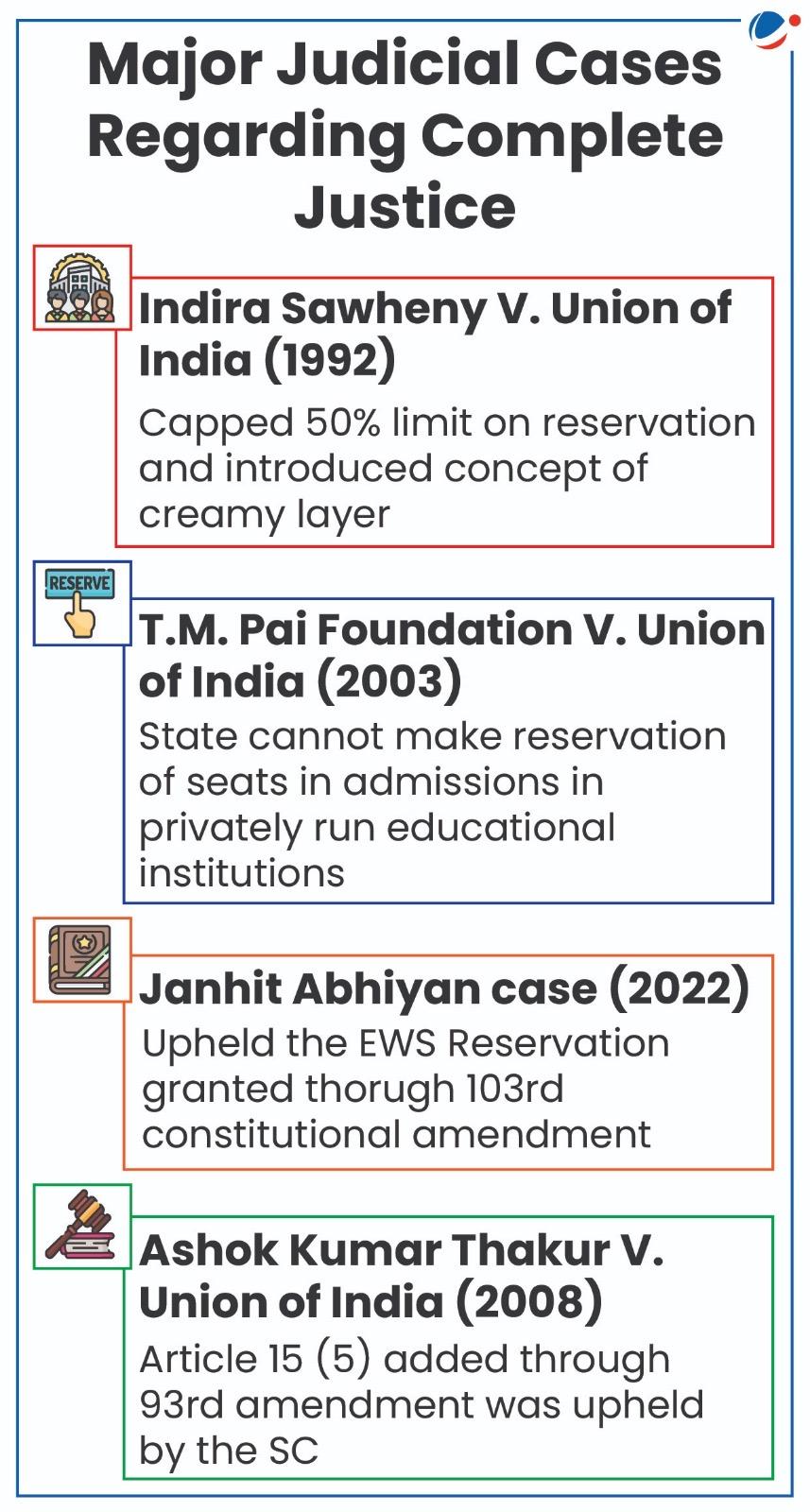Why in the News?
The Supreme Court recently nullified the outcome of the Chandigarh Mayor election, exercising its power under Article 142 of the Constitution to ensure "complete justice".
What is Idea of Complete Justice?
|
About Article 142
- The Supreme Court in the exercise of its jurisdiction may pass such decree or make such order as is necessary for doing complete justice in any cause or matter pending before it.
- Enables the Supreme Court to exercise executive and legislative functions in specific scenarios, including issuing guidelines, directives, or orders to governmental bodies or other authorities.
- Permits the Supreme Court to intervene in matters concerning public interest, human rights, constitutional values, or fundamental rights, safeguarding them against any form of violation or infringement.
- Elevates the Supreme Court's role as the protector of the constitution and ultimate interpreter of the law, serving as a catalyst for judicial activism and innovation.
Positive Impacts of Article 142
- Address urgent issue with legislative vacuum: Proactive approach enables courts to provide remedies and resolutions in cases where absence of legislation can hinder the delivery of swift justice and lead to irreparable harm.
- In Bhanwari Devi and Ors. vs State of Rajasthan (2002), the SC provided "the Vishaka Guidelines" to address workplace sexual harassment, eventually resulting in "the Prevention of Sexual Harassment Act, 2013".
- Cleaning of Taj Mahal, Release of undertrials, and the Union Carbide case are few more examples of judicious use of article 142.
- Strengthen Democracy: It protects the rights of minorities and ensures that all voices are heard and respected within the democratic process.
- K.S. Puttaswamy (Privacy) vs. Union of India (2017) established guidelines for safeguarding individual privacy.
- Provides Checks and Balances: It serves as a crucial check on government branches, preventing overreach and protecting citizens.
- In 2014, the SC canceled all but four of the 218 coal block allocations deemed illegal and arbitrary.
- Civil rights and social justice: By addressing issues overlooked or avoided by the legislative and executive branches.
- In Vineeta Sharma vs. Rakesh Sharma & Ors. (2020) SCaddressed conflicting judgments on daughters' coparcenary rights under Hindu Succession Act.
- Promotes equality: By challenging discriminatory laws and practices, ensuring equal protection under the law irrespective of race, gender, sexual orientation, or other characteristics.
- In The Secretary, Ministry of Defense vs. Babita Puniya case SC granted permanent commission to women officers in the Indian Army.
Issues with Article 142

- Subjectivity in the definition: While using article 142, court has wide discretion, and this allows the possibility of its arbitrary exercise or misuse due to the absence of a standard definition for the term "complete justice".
- Defining "complete justice" is a subjective exercise that differs in its interpretation from case to case.
- Blurs the Lines Between Branches: Judicial activism may sometimes blur boundaries between judiciary and legislature, causing confusion in roles, leading to jurisdictional conflicts.
- S.R. Bommai vs. Union of India (1994): The SC's intervention in Karnataka's political crisis with a floor test blurred judiciary-executive lines, sparking concerns of overreach.
- Unaccountability: Article 142 grants the judiciary, unlike the executive and legislative branches, immunity from easy scrutiny or challenge for its decisions.
- The power has also been criticised on grounds of the separation of powers doctrine.
- Lack of Consistency: Inconsistent legal rulings under Article 142 complicate litigation planning and operations for individuals and businesses.
Way Forward
- Addressing Arbitrariness: Judges should ensure that decisions made under Article 142 are based on relevant facts and considerations, avoiding arbitrary use of power.
- While Article 142 provides a flexible approach to remedy shortcomings in legislation, it should not be misused.
- Defining 'complete justice': The ambiguity of the term 'complete justice' should not be exploited to justify arbitrary decisions.
- Clear guidelines or principles can help mitigate misuse of power under the guise of achieving 'complete justice'.
- Establishing a regulatory framework: To prevent misuse of Article 142 decisions should be subject to scrutiny and accountability, ensuring that all relevant parties are heard before invoking Article 142.
- Referral to Constitution Bench: Referral of all cases invoking Article 142 to a Constitution Bench of at least five judges.





